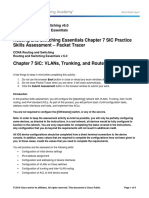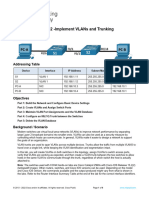0% found this document useful (0 votes)
147 views10 pagesEnterprise Network Project
The document outlines the design and implementation requirements for a new network at a trading floor support center moving to a new building. It details the hierarchical network model, including redundancy measures, VLAN configurations, IP addressing schemes, and device configurations necessary to support 600 staff across three floors and multiple departments. The design emphasizes scalability, efficient routing, and secure communication while utilizing Cisco Packet Tracer for simulation.
Uploaded by
alaabachab99Copyright
© © All Rights Reserved
We take content rights seriously. If you suspect this is your content, claim it here.
Available Formats
Download as ODT, PDF, TXT or read online on Scribd
0% found this document useful (0 votes)
147 views10 pagesEnterprise Network Project
The document outlines the design and implementation requirements for a new network at a trading floor support center moving to a new building. It details the hierarchical network model, including redundancy measures, VLAN configurations, IP addressing schemes, and device configurations necessary to support 600 staff across three floors and multiple departments. The design emphasizes scalability, efficient routing, and secure communication while utilizing Cisco Packet Tracer for simulation.
Uploaded by
alaabachab99Copyright
© © All Rights Reserved
We take content rights seriously. If you suspect this is your content, claim it here.
Available Formats
Download as ODT, PDF, TXT or read online on Scribd
/ 10

















































































